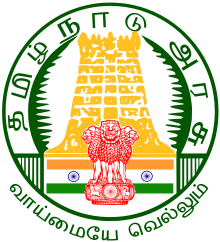Portal:Tamils
The Tamils portal
The Tamils (/ˈtæmɪlz, ˈtɑː-/ TAM-ilz, TAHM-), also known as the Tamilar, are a Dravidian ethnolinguistic group who natively speak the Tamil language and trace their ancestry mainly to the southern part of the Indian subcontinent. The Tamil language is one of the longest-surviving classical languages, with over two thousand years of written history, dating back to the Sangam period (between 300 BCE and 300 CE). Tamils constitute about 5.7% of the Indian population and form the majority in the South Indian state of Tamil Nadu and the union territory of Puducherry. They also form significant proportion of the population in Sri Lanka (15.3%), Malaysia (7%) and Singapore (5%). Tamils have migrated world-wide since the 19th century CE and a significant population exists in South Africa, Mauritius, Fiji, as well as other regions such as the Southeast Asia, Middle East, Caribbean and parts of the Western World.
Archaeological evidence from Tamil Nadu indicates a continuous history of human occupation for more than 3,800 years. In the Sangam period, Tamilakam was ruled by the Three Crowned Kings of the Cheras, Cholas and Pandyas. Smaller Velir kings and chieftains ruled certain territories and maintained relationship with the larger kingdoms. Urbanisation and mercantile activity developed along the coasts during the later Sangam period with the Tamils influencing the regional trade in the Indian Ocean region. Artifacts obtained from excavations indicate the presence of early trade relations with the Romans. The major kingdoms to rule the region later were the Pallavas (3rd–9th century CE), and the Vijayanagara Empire (14th–17th century CE). The island of Sri Lanka often saw attacks from the Indian mainland with the Cholas establishing their influence across the island and across several areas in Southeast Asia in the 10th century CE. This led to the spread of Tamil influence and contributed to the cultural Indianisation of the region. Scripts brought by Tamil traders like the Grantha and Pallava scripts, induced the development of many Southeast Asian scripts. The Jaffna Kingdom later controlled the Tamil territory in the north of the Sri Lanka from 13th to 17th century CE. European colonization began in the 17th century CE, and continued for two centuries until the middle of the 20th century. (Full article...) Selected article - Tamil Nadu (/ˌtæmɪl ˈnɑːduː/; Tamil: [ˈtamiɻ ˈnaːɽɯ] , abbr. TN) is the southernmost state of India. The tenth largest Indian state by area and the sixth largest by population, Tamil Nadu is the home of the Tamil people, who speak the Tamil language, one of the longest surviving classical languages and which serves as its official language. The capital and largest city is Chennai. Located on the south-eastern coast of the Indian peninsula, Tamil Nadu is straddled by the Western Ghats and Deccan Plateau in the west, the Eastern Ghats in the north, the Eastern Coastal Plains lining the Bay of Bengal in the east, the Gulf of Mannar and the Palk Strait to the south-east, the Laccadive Sea at the southern cape of the peninsula, with the river Kaveri bisecting the state. Politically, Tamil Nadu is bound by the Indian states of Kerala to the west, Karnataka to the northwest, Andhra Pradesh to the north, and encloses part of the union territory of Puducherry. It shares an international maritime border with the Northern Province of Sri Lanka at Pamban Island. (Full article...)General imagesSelected biography -The chief minister of Tamil Nadu is the chief executive of the Indian state of Tamil Nadu. In accordance with the Constitution of India, the governor is a state's de jure head, but de facto executive authority rests with the chief minister. Following elections to the Tamil Nadu Legislative Assembly, the state's governor usually invites the party (or coalition) with a majority of seats to form the government. The governor appoints the chief minister, whose council of ministers are collectively responsible to the assembly. Given that he has the confidence of the assembly, the chief minister's term is for five years and is subject to no term limits. Since 1952, Tamil Nadu has had 12 chief ministers, 13 including V. R. Nedunchezhiyan, who twice acted in the role. The longest-serving chief minister, M. Karunanidhi from Dravida Munnetra Kazhagam held the office for over eighteen years in multiple tenures, while he was the one who had the largest gap between two terms (nearly thirteen years). The All India Anna Dravida Munnetra Kazhagam's former general secretary J. Jayalalithaa has the second-longest tenure, and its founder M. G. Ramachandran, the first actor to become the chief minister in India has the third-longest tenure, while his wife V. N. Janaki Ramachandran has the shortest tenure (only 23 days). K. Kamaraj resigned his post of his own free will and devoted all of his energy to the revitalization of the Indian National Congress party; he was responsible for the elevation of Lal Bahadur Shastri to the position of Prime Minister of the Republic of India following the death of Jawaharlal Nehru and of Indira Gandhi following the death of Lal Bahadur Shastri. C. Rajagopalachari served as the last Governor-General of the Union of India before becoming chief minister of undivided Madras State. There have been four instances of president's rule in Tamil Nadu, most recently in 1991. (Full article...)CategoriesTopicsTamil People Countrywide: India • Sri Lanka • Canada • Malaysia • Singapore • South Africa • England Related Ethnic Groups: Brahui • Gond • Kannadiga • Khonds • Kodava • Oraon • Malayali • Telugus • Tuluvas Related indigenous Groups: Badagas • Toda • Kuruba
See also: List of Tamil people, Tamil script, Tamil Script Code for Information Interchange Related portalsWikiProjectsThings to do
Associated WikimediaThe following Wikimedia Foundation sister projects provide more on this subject:
Discover Wikipedia using portals |


























































